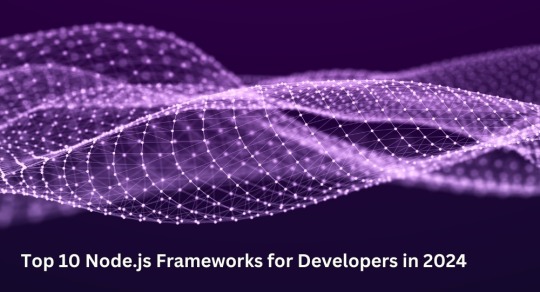#fastify
Explore tagged Tumblr posts
Link
This article will present some of the most widely Node.js REST API Frameworks that are still popular in 2023 by highlighting their pros and cons and viewing a simple example to evaluate how they can be used in action.
0 notes
Text

It's large it's unwieldy it's ungodly it's gonna block out to the size of a big

I've also got this going which I'll try not to bother you guys too much with
#every time i do this i am shocked at the amount of progress between pictures#we are 2 of three yarnballs in and not quite at size b yet which means i think i fucked up my gauge#but thats ok cause once size b hits then its all about using up the remaining yarn#i did kinda fuck up gauge by figuring out how to fastify knit stitches#havent been able to tightwad knit since then as effectively#530 some stitches rn#too many
31 notes
·
View notes
Text
Top 10 Node.js Frameworks for Developers in 2024

Node.js continues to dominate the backend development space in 2024, offering developers a fast, scalable environment to build dynamic web applications. With a vast ecosystem of frameworks, each serving specific use cases, choosing the right one can significantly enhance productivity and project performance. In this blog, we’ll explore the top 10 Node.js frameworks every developer should consider in 2024.
1. Express.js
Express.js remains the most popular Node.js framework due to its simplicity and flexibility. Known as the “de facto” standard, Express provides a minimalist yet powerful set of features for building web and mobile applications. It’s lightweight, easy to integrate with databases, and supports middleware, making it ideal for both beginners and seasoned developers.
Best for: RESTful APIs, single-page applications (SPAs), and server-side rendering (SSR).
2. NestJS
NestJS has seen remarkable growth in 2024. It’s a progressive framework that offers a solid architecture based on TypeScript, combining elements of object-oriented programming (OOP), functional programming (FP), and reactive programming. NestJS is particularly suited for building scalable and maintainable enterprise-level applications.
Best for: Enterprise applications, microservices, and API gateways.
3. Fastify
Fastify is becoming the go-to framework for developers seeking performance. True to its name, Fastify is focused on speed, with a highly efficient HTTP server. It has a low overhead and offers out-of-the-box JSON schema-based validation, making it ideal for real-time, high-performance applications.
Best for: High-performance APIs, real-time applications, and microservices.
4. Koa.js
Koa.js, created by the same team behind Express, is a minimalist framework that strips away unnecessary layers, allowing developers more control over middleware. With async/await functionality and no bundled middleware, Koa is perfect for developers looking for flexibility without sacrificing performance.
Best for: Building APIs with flexible middleware management.
5. Sails.js
Sails.js remains a top choice for developers looking to build full-fledged web applications quickly. It follows the MVC (Model-View-Controller) pattern and is inspired by Ruby on Rails. Sails comes with a robust ORM called Waterline, supporting various databases without changing code structure.
Best for: Data-heavy applications, real-time apps, and enterprise applications.
6. Meteor.js
Meteor.js continues to be a strong contender in 2024, offering full-stack JavaScript development. With Meteor, developers can build both the frontend and backend using the same codebase. Its real-time data synchronization across clients and servers makes it an excellent choice for building reactive apps.
Best for: Real-time applications, collaborative tools, and full-stack development.
7. Adonis.js
Adonis.js is another rising star in 2024, offering an elegant, full-featured ecosystem. It follows the MVC pattern and comes with many built-in tools like authentication, validation, and database migrations, making it suitable for building scalable applications with less effort.
Best for: Full-featured web applications, API development, and enterprise-level projects.
8. Hapi.js
Hapi.js is known for its robustness and configuration-centric approach. Used by large enterprises, Hapi allows developers to focus on writing reusable business logic instead of dealing with HTTP protocol minutiae. With built-in input validation, caching, and authentication, Hapi is a secure and mature framework.
Best for: Large-scale applications, secure and scalable APIs.
9. LoopBack
LoopBack is a highly extensible framework for building APIs, and it shines when working with databases. With strong support for connecting to multiple data sources, including REST APIs, GraphQL, and SOAP services, LoopBack allows developers to create scalable and well-structured APIs with minimal setup.
Best for: API-driven development, database-heavy applications, and microservices.
10. Feathers.js
Feathers.js is a lightweight framework that allows developers to build real-time applications easily. With its minimalistic core and modular structure, Feathers enables you to plug in only what you need. It’s particularly suited for apps that require real-time updates and socket communication.
Best for: Real-time applications, REST APIs, and microservices.
Conclusion
As the Node.js ecosystem continues to expand in 2024, developers are presented with a wide range of frameworks to choose from, each catering to different needs. Whether you’re building high-performance APIs, full-stack web applications, or enterprise-level solutions, there’s a framework that can streamline your development process. Express.js, NestJS, and Fastify remain top choices, while frameworks like Koa.js and Adonis.js offer flexibility and a rich set of features.
Ultimately, the right choice depends on your project requirements, scalability needs, and the desired level of control over your codebase. Stay updated with the latest advancements and experiment with these frameworks to find the best fit for your development goals in 2024.
#career#virtualinternship#internship#internshipgate#internship in india#education#nodejs#job opportunities#framework
1 note
·
View note
Text
SvelteKit for everything or + Express/Fastify
Hello fellow Svelte users.
I am trying to develop a full-stack side project using Svelte/SvelteKit. If I'm using NodeJS for everything am I supposed to use Express/Fastify for the real backend or just use SvelteKit all the way down?
I don't have any real world experience with this new meta framework era. It feels like I will be duplicating backend logic in SvelteKit and Express/Fastify, but at the same time I am not sure what I am losing by not using dedicated backend frameworks.
Please share your experience, thank you.
0 notes
Text
10 Most Popular Backend Frameworks for Web Development in 2024
In 2024, leading web development companies favor the following 10 backend frameworks: Express.js, Django, Ruby on Rails, Flask, Laravel, Spring Boot, ASP.NET Core, Symfony, NestJS, and Fastify. These frameworks are renowned for their scalability, performance, and versatility, offering developers robust tools for building dynamic web applications. With features for database management, user authentication, and seamless API integration, they streamline the development process and ensure efficient project delivery. Each framework caters to specific programming languages and ecosystems, empowering developers to select the most suitable option for their projects' needs. As such, they remain indispensable tools in the arsenal of web development companies worldwide.
#australia#devstreeau#mobileappdevelopment#iphone#mobile app developer company#web app development#ios#mobile app company#iot app development#iot applications#web app development company#web development
0 notes
Text
What are some of the best frameworks of Node.js for web applications
Node.js has a vibrant ecosystem with numerous frameworks that can be utilized for building web applications. Some of the best frameworks for Node.js are:
Express.js: Express.js is a fast and minimalist web framework that has been widely adopted in the Node.js community. It offers a straightforward and unopinionated approach, making it ideal for building scalable and lightweight web applications. Express.js provides essential features such as routing, middleware support, and template engines, allowing developers to quickly create robust web APIs or server-side applications.
Koa.js: Koa.js is a modern and lightweight framework that builds upon the success of Express.js. It focuses on improving code readability and simplifying middleware composition. Koa.js introduces the concept of async/await, making it easier to write asynchronous code. With its modular architecture and intuitive API, Koa.js is an excellent choice for developers who prefer a more modern and elegant framework.
Nest.js: Nest.js is a progressive framework that combines elements of both Node.js and TypeScript. It follows the architectural principles of Angular, allowing developers to build scalable and maintainable server-side applications. Nest.js provides a solid foundation for building enterprise-grade applications, offering features such as dependency injection, middleware support, and a powerful module system.
Hapi.js: Hapi.js is a powerful and flexible framework designed for building HTTP applications. It emphasizes configuration-driven development, making it highly customizable and suitable for complex projects. Hapi.js provides a comprehensive set of plugins and tools, enabling developers to create secure APIs and real-time applications with ease.
Fastify: Fastify is a highly performant and low-overhead framework built specifically for speed. It boasts excellent throughput and response times, making it an ideal choice for high-performance applications. Fastify supports a wide range of plugins and features, including schema validation, logging, and caching, allowing developers to build efficient and scalable web applications.
These frameworks offer different features, styles, and levels of abstraction, catering to various development preferences and project requirements. It's important to assess your specific needs and consider factors like scalability, performance, ease of use, and community support when selecting the best framework for your Node.js development.
0 notes
Text
Intermittent Fasting is made easy with these 8 Best Apps of 2023
Intermittent fasting is a popular diet trend, and there are many apps that can help you track your eating habits and stick to your fasting schedule. Here are 8 of the best Intermittent fasting apps for 2023:
Zero – This app offers a simple and intuitive interface for tracking your fasts.
MyFitnessPal – A well-known fitness app that now offers Intermittent fasting tracking features.
FastMate – A app designed specifically for Intermittent fasting, with features like reminders, goal tracking and community support.
Fastify – An app that uses AI to tailor a fasting plan to your individual needs.
LifeApp – A wellness app that incorporates Intermittent fasting with mindfulness and stress reduction.
Intermittent Fasting Tracker – A straightforward app that allows you to easily log your fasts and see your progress.
Intermittent Fasting Coach – An app that provides guidance and support for those new to Intermittent fasting.
Intermittent Fasting – A comprehensive app that offers meal planning, tracking, and educational resources.
Start-ups looking to incorporate Intermittent fasting should consider these top apps to stay ahead of the trend.
Content Source
0 notes
Photo

Fastify 3.0 is a Node.js web framework. The new version of Fastify 3.0 includes full support for TypeScript and Express middleware, new type definitions, LTS support cycle, refactored request validation, and more.
If you are looking for expert web development services, contact us: https://bit.ly/3jizuzH
0 notes
Photo

Build a web app using Nestjs, Fastify, MongoDB and Angular 8 https://morioh.com/p/71f993016161 #nestjs #fastify #mongodb #angular #development
0 notes
Link
RESTful APIs are essential because they provide a simple, standardized way of accessing data and services over the web. They are also very robust, allowing developers to easily create and maintain resilient applications to underlying data or service changes changes changes. In addition, RESTful APIs are generally more straightforward to use than others, providing developers with a more consistent experience across devices and platforms. Finally, RESTful APIs are often faster and more secure than different APIs due to their reliance on a stateless protocol. This article discusses some factors to consider when choosing a Framework for Building RESTful APIs.
#REST#api#framework#web_service#spring_boot#Ruby_on_Rails#flask#Django_REST#ExpressJs#Fastify#Play#Gin#Phoenix#Fast_API
0 notes
Photo

Learn to build the efficient, reliable and scalable server-side web app using Nestjs, Fastify, MongoDB and Angular 8 https://morioh.com/p/71f993016161 #nestjs #fastify #mongodb #angular #development
0 notes
Photo

Learn to build the efficient, reliable and scalable server-side web app using Nestjs, Fastify, MongoDB and Angular 8 https://morioh.com/p/71f993016161 #nestjs #fastify #mongodb #angular #development #javascript #nodejs #code #geek #morioh
0 notes
Text
0 notes
Photo
These are my friend's OCs Fastifi and Saiya from the Edge of the Empire game we're running!


Commissions for @tieflingkisser
Thank you for commissioning me!
87 notes
·
View notes
Text
Hello World! Again!
After 3 months of non-stop development, many missed college classes, 1000+ commits on GitHub, and definitely more cups of coffee, HEYHEY is finally reaching its initial design goals. Just like we mentioned in our introductory blog post, HEYHEY is all about helping you centralize your digital presence while expanding on what a personal web page can be.

Today, as a free user, you already have access to 4 beautiful themes, animated profile pictures, the ability to post basic content, and your own username that points to heyhey.to/[USERNAME]. We even innovated on usernames: no longer are you bound to using the 26-letter English alphabet — you can use ANY alphabet you want. For instance, heyhey.to/Gün is possible on HEYHEY but not on other platforms.
As a Pro user, you get access to more themes that let you express yourself in different styles; Analytics, which allows you to see valuable information like how many people visited your page, how long they hang around, and if they clicked on anything; and The Shop, which lets you sell digital goods without any DRM.

In our first devlog, we outlined HEYHEY's tech stack. We are extremely happy with all the decisions that were made as they allowed us to quickly build software without causing any performance degradations. Fastify, TailwindCSS, and DaisyUI are simply the best tools for one-person-army type of development flows. If you're thinking about starting your own web-based venture, consider using them!
Now, we want to be clear: we are far from done. There are some rough edges, not every feature that's on the roadmap has shipped, and we're STILL debating how to do Widgets (we need to create a uniform way of embedding content that belongs to other websites — like a Twitch stream or a YouTube video — while respecting theming).
For Analytics, HEYHEY actually collects more information (in a privacy-preserving first-party way) than what's shown on the panel, we are exploring ways of displaying them as well. That means, in the future, you should be able to see where exactly people are coming from (digitally and geographically), and where they're headed on your profile page.
The Shop is missing many quality of life improvements, and we want to give more control to creators on how they choose to fund themselves. So a Tip Button, for instance, might be a reality!
The biggest problem, and what's blocking us from releasing The Shop, is a legal issue. We still haven't set up a company to manage HEYHEY. We are working on it, though!

We invite you to take HEYHEY for a spin, give us feedback (it has a considerable chance of shaping the product), and, if satisfied, support us by subscribing to Pro.
See you soon, hopefully with more feature announcements!

7 notes
·
View notes
Photo

Building a Fast Serverless API on AWS with Fastify and AWS Amplify: https://t.co/YNuHG7WIjW #video
1 note
·
View note